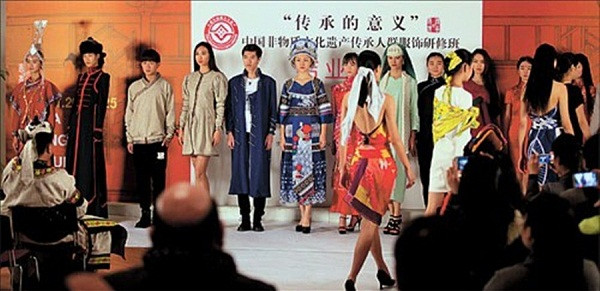
Models sport new designs that incorporate the elements of traditional ethnic group garments at a party completing a six-week program in Shanghai that helps find a way forward for garments produced by China's ethnic minorities.(Photo/Shanghai Daily)
Ma Mengran wasn't sure about her future. On the one hand, the 29-year-old loved to teach kindergarten. On the other hand, there was crochet. A member of the Hui Ethnic Group in Xinjiang Uygur Autonomous Region, Ma grew up with the tradition of crocheting garments. Her own mother is a so-called inheritor, one of few remaining masters of the centuries-old tradition. Although she wanted to help preserve her cultural heritage, crocheting caused her mother health issues, and overall, Ma found the work to be dull and too solitary.
"Just several years ago, nothing was more boring than crochet to me. In fact, I even tried to persuade my mother to stop because I believed it ruined her health."
Her mother, Ma Yaolan, has crocheted shirts, jackets and coats for three decades — a work that, due to her head being bowed down for most of the time, has left her with severe cervical spondylosis. The condition, said Ma, leads to insufficient blood supply to the brain, and landed her mother in hospital twice.
"During her second hospitalization, I began to think about what made her carry on, despite the difficulties," said Ma. That's when she picked up crocheting again. Like her mother, she spent hours on end pulling loops through one another with a little needle. But, unlike before, the work didn't bore her. "While I tried to understand her, I found the fun of crochet as well."
Ma has decided that she will carry her community's traditional crochet craft into the future. For the past one and a half months she was in Shanghai to participate in a program that helps find a way forward for garments produced in a traditional way by China's ethnic minorities. Members from communities across China joined the workshops at the Shanghai Institute of Visual Art, and many, including Ma, now feel reaffirmed in their decision.
"The program made me think over again why I decided to pursue the career, which I once despised so much," said Ma. In a way, she said that she felt the responsibility to make sure that the crochet craft of the Hui minority survived. And that, she realized during the workshop, would only be possible if she managed to adapt it for modern day society.
"Protecting culture is not keeping the culture in a display case, but to make the culture part of people's daily life," said Yu Zhenwei, the institute's vice president.
The first thing the future 'inheritors' had to learn, he said, was to take their craft off of its pedestal.
"The key part is to break the old thoughts that the culture belongs only to 'old tradition'." Like other traditional crafts, the Hui's culture of wearing crocheted garments can be adopted to fit modern styles, he said.
The workshop taught Ma "how to blend the traditional fashion into modern people's lives," she said.
"Before, I believed that traditions should stay traditional, so I always stuck to the old patterns and styles," she said.
For her final work, Ma chose to crochet a long waistcoat and a Taqiyah, a praying cap. Both are white, considered the purest color in Islamic culture, Ma said. The sleeveless waistcoat can be worn over pants and a shirt, giving the outfit a simple elegance.
"Apart from Islamic culture, I'm also thinking to use elements of my hometown in crochet design," said Ma. "Even food, such as da la pi (tossed clear noodle), can be designed into a pattern."
All garments selected for the program belong to China's intangible cultural heritage. As fast fashion is available across the country, fewer and fewer people are interested in wearing traditional garments, and the old masters have nobody to pass their craft on to. Sichuan embroidery has suffered such a fate.
Once known as one of the four most important embroidery styles in China, Sichuan embroidery was as popular gift and souvenir up until the 1990s. Designs remained the same for decades, and factories worked on outdated, inefficient production lines under old-fashioned management regimes. Better infrastructure and a wider range of souvenirs saw tourism sales decline. More than 10 years ago, the last embroidery plant shut down.
Now, there's a small revival, said Wang Hui from Chongqing, who hopes to call herself a Sichuan embroidery inheritor in the future.
In a newspaper article, Wang read about a local master who noted the craft's disappearance. She decided to phone him. Today, the man from the article is Wang's master.
"I have my own fashion company, and I was very keen to incorporate Sichuan embroidery into my designs," said Wang, adding that she had been interested in embroidery since she was a child.
The workshop gave Wang new ideas. After she returns home, Wang said that she would try to work on ways to include embroidery in more daily fashion.
"I believe that I can help bring the embroidery to the top again," she said.
Ma, too, is excited to return home to apply what she has learned in Shanghai.
"The lecturers broadened my mind. Now I know I can use my imagination and my interest and everything in designing crochets," she said.


















































